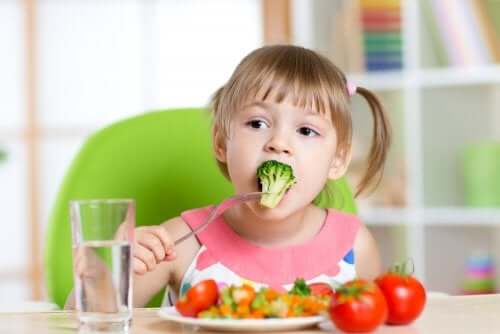The Value of Discipline in Healthy Eating


Written and verified by the pedagogue and trainer María Matilde
In almost every area of life, being disciplined helps you get things done right and meet your goals. Just like when you work, study, build something, play a sport or diet, discipline plays a key role. In this article, we’ll discuss the educational value of discipline in healthy eating as a way to internalize consistent habits, order and strength. And, in turn, it will help in maintaining a proper diet and achieving good overall health.
Discipline and healthy eating
Discipline refers to a set of standards or rules whose compliance leads to a certain result. In other words, it refers to order and its maintenance as a condition to achieving or obtaining something. We could also intuit that, in order to achieve a certain order, a certain amount of anticipation or foresight is necessary.

Therefore, discipline in healthy eating implies establishing order and a set of norms to follow in order to achieve proper nutrition. Of course, the objective can also be losing weight, consuming less sugar or fewer processed foods, or increasing the consumption of vegetables and fruits. But either way, it’s all about finding a balance in the nutrients we consume and maintaining good nutrition.
Learning how to eat and how to feed ourselves correctly
Discipline in healthy eating has an important educational component and we must educate children and youth in this value. The very act of eating requires order, regularity, hygiene, and certain behaviors as conditions for proper nutrition. Therefore, to educate our children regarding good nutrition, we must focus on the internalization of habits and routines that are appropriate in this sense.
So, both at schoool and at home, students and children must learn from an early age to eat correctly. In other words, it’s important for them to learn what foods to eat, in what way, and at what times, as a way of staying healthy and avoiding disease.

How to achieve discipline in healthy eating
Finally, in order for our children and students to be disciplined in their eating, they must progressively learn the following:
- The importance of a routine regarding food. This implies schedules, adequate places, correct ways of sitting and handling silverware, and hygiene measures.
- Progressively get to know the types, characteristics, and benefits of food. To know how to eat in a balanced way, incorporating the correct portions of proteins, carbohydrates, and healthy fats in meals, and discarding or minimizing the intake of junk food (industrial baked goods and very processed foods or with high sugar content).
- Understand the relationship between healthy eating and personal development. Learning discipline in healthy eating allows children and young people to understand the benefit of a good diet as a means of achieving health at a physical, intellectual, and emotional level.
- Learn about the importance of helping parents at home and with grocery shopping. Specifically, they should learn about the need for good organization and meal planning as a way to achieve proper nutrition.
In almost every area of life, being disciplined helps you get things done right and meet your goals. Just like when you work, study, build something, play a sport or diet, discipline plays a key role. In this article, we’ll discuss the educational value of discipline in healthy eating as a way to internalize consistent habits, order and strength. And, in turn, it will help in maintaining a proper diet and achieving good overall health.
Discipline and healthy eating
Discipline refers to a set of standards or rules whose compliance leads to a certain result. In other words, it refers to order and its maintenance as a condition to achieving or obtaining something. We could also intuit that, in order to achieve a certain order, a certain amount of anticipation or foresight is necessary.

Therefore, discipline in healthy eating implies establishing order and a set of norms to follow in order to achieve proper nutrition. Of course, the objective can also be losing weight, consuming less sugar or fewer processed foods, or increasing the consumption of vegetables and fruits. But either way, it’s all about finding a balance in the nutrients we consume and maintaining good nutrition.
Learning how to eat and how to feed ourselves correctly
Discipline in healthy eating has an important educational component and we must educate children and youth in this value. The very act of eating requires order, regularity, hygiene, and certain behaviors as conditions for proper nutrition. Therefore, to educate our children regarding good nutrition, we must focus on the internalization of habits and routines that are appropriate in this sense.
So, both at schoool and at home, students and children must learn from an early age to eat correctly. In other words, it’s important for them to learn what foods to eat, in what way, and at what times, as a way of staying healthy and avoiding disease.

How to achieve discipline in healthy eating
Finally, in order for our children and students to be disciplined in their eating, they must progressively learn the following:
- The importance of a routine regarding food. This implies schedules, adequate places, correct ways of sitting and handling silverware, and hygiene measures.
- Progressively get to know the types, characteristics, and benefits of food. To know how to eat in a balanced way, incorporating the correct portions of proteins, carbohydrates, and healthy fats in meals, and discarding or minimizing the intake of junk food (industrial baked goods and very processed foods or with high sugar content).
- Understand the relationship between healthy eating and personal development. Learning discipline in healthy eating allows children and young people to understand the benefit of a good diet as a means of achieving health at a physical, intellectual, and emotional level.
- Learn about the importance of helping parents at home and with grocery shopping. Specifically, they should learn about the need for good organization and meal planning as a way to achieve proper nutrition.
All cited sources were thoroughly reviewed by our team to ensure their quality, reliability, currency, and validity. The bibliography of this article was considered reliable and of academic or scientific accuracy.
- Gutiérrez Silva, C. y Sánchez-Sosa, J. J. (2006). Ambiente familiar, alimentación y trastornos de la conducta alimentaria. Revista Mexicana de Psicología, 23(2), pp. 173-183. Recuperado de https://www.redalyc.org/pdf/2430/243020649003.pdf
- Izquierdo Hernández, A., Armenteros Borrell, M., Lancés Cotilla, L. y Martín González, I. (2004). Alimentación saludable. Revista cubana de enfermería, 20(1), 1-1. Recuperado de http://scielo.sld.cu/scielo.php?script=sci_arttext&pid=S0864-03192004000100012
- Muñoz Cano, J. M., Santos Ramos, A. J. y Maldonado Salazar, T. D. N. J. (2013). Elementos de análisis de la educación para la alimentación saludable en la escuela primaria. Estudios sociales (Hermosillo, Son.), 21(42), pp. 205-231. Recuperado de http://www.scielo.org.mx/pdf/estsoc/v21n42/v21n42a9.pdf
This text is provided for informational purposes only and does not replace consultation with a professional. If in doubt, consult your specialist.








